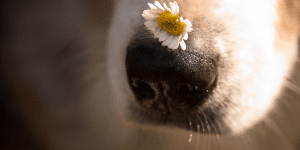Can Dogs Suffer From Hay Fever?
Just like people, it is possible for our pet dogs to suffer with hay fever symptoms. The same pollens which can affect humans in the summer months, can also be irritants for dogs too. Holidays4Dogs finds out what symptoms to look out for and how you can ease the effects of hay fever in dogs.
The symptoms of hay fever in canines can be quite similar to those in people and is a relatively common condition. The difference perhaps, is that dogs tend to suffer more with skin irritations and rashes. Sneezing, runny eyes and noses are less common symptoms in dogs and are usually associated with other health conditions.
Symptoms.
When a dog has an allergic reaction to pollen particles, histamines are released in a dog’s skin. Being in close contact with grass, or rolling in vegetation can trigger a reaction in the dog’s body. As a result, this can often cause the skin to become very itchy. The dog may constantly scratch and nibble, making the skin red and sore.
As a result, this can often cause the skin to become very itchy. The dog may constantly scratch and nibble, making the skin red and sore.
Some dogs are more prone to the effects of hay fever than others. Dalmatians, poodles, west highland terriers, and schnauzers all seem to be particularly prone to hay fever.
Dogs that have had less exposure to grass and trees while young, can suffer more with hay fever in later life because they have a lower tolerance to allergens.
The only way to find out whether your dog has hay fever is to take him to the vet to be tested for allergens. A veterinary consultation can also rule out other health conditions that may mimic hay fever.
If your dog is reacting to allergens your vet can prescribe antihistamines. However, it is important to remember you should never give your dog any drug meant for human consumption, as this could be highly toxic to dogs.
If you suspect your dog is suffering from the effects of hay fever during the spring and summer months (April – September) there are a few things you can do to reduce the effects.
-
If possible, keep your dog’s fur trimmed, or clipped short.
-
Walk your dog earlier or later in the day when the pollen count is lower.
-
Avoid woodland areas, or fields with long grass.
-
After a walk, wipe or rinse your dog to help get rid of pollen from his fur.
Feeding a raw, grain free diet, can often help with allergies and skin irritations. Raw food helps build the immune system and combat skin complaints in particular.
At Holidays4Dogs we always advise that it is best to consult your vet about matters relating to your pet’s health. Some of the hay fever symptoms in dogs described here, could relate to other serious health conditions.


